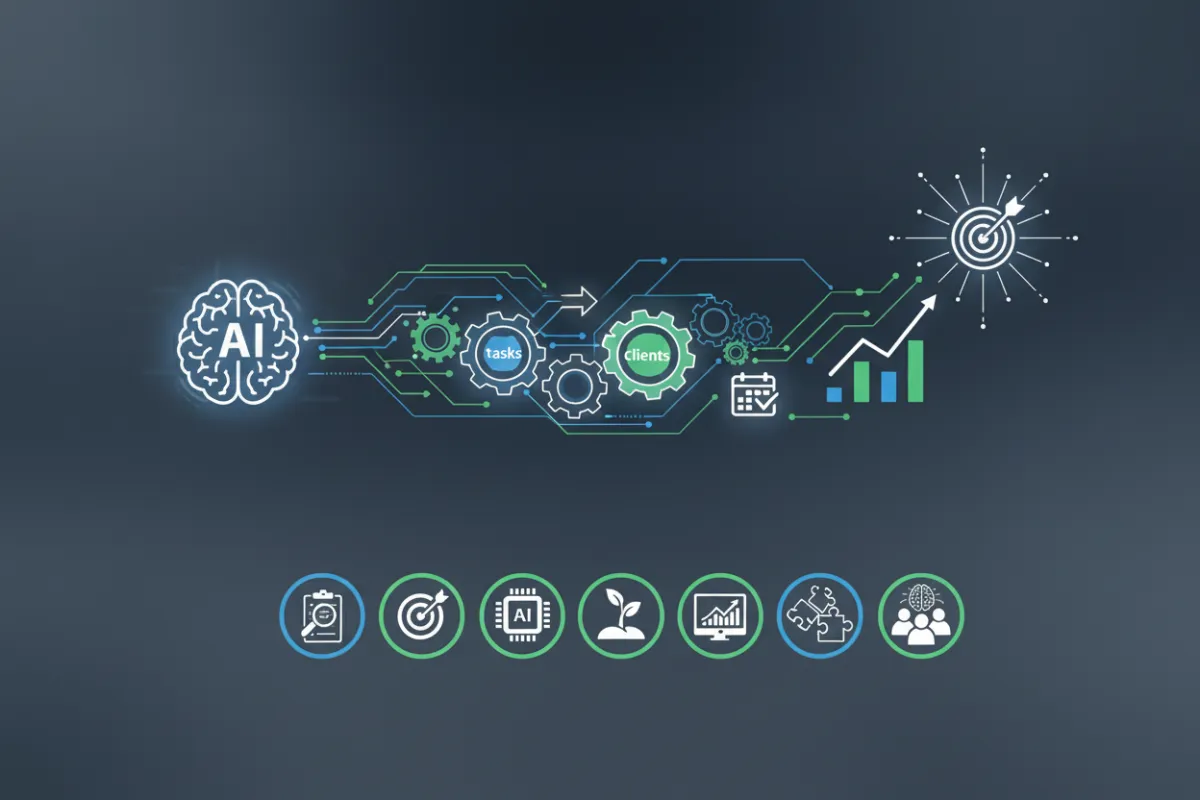Blog

7 Steps to Make AI Assistants Work for Small Businesses
7 Steps to Make AI Assistants Work for Small Businesses
In this post, you'll discover a step-by-step guide to leverage AI assistants for your small business, so you can streamline repetitive tasks, attract more clients, and reclaim precious time for the work that truly matters.The results speak for themselves: according to Gartner, 80% of customer interactions will be handled by AI by 2025, and businesses using automation report a 22% reduction in operating costs (Deloitte, 2023). Imagine freeing up your team, enhancing your client experience, and growing faster—all at a fraction of the agency price.
Unfortunately, most small business owners believe AI assistants are complicated, expensive, and only for tech giants.
The Real Reasons AI Feels Out of Reach
Lack of Time: Small teams are already stretched thin and can't imagine adding "learn new technology" to their to-do list.
Budget Worries: Many assume advanced tech means hefty monthly bills or surprise setup costs.
Technical Intimidation: AI seems to require coding chops or advanced degrees—especially for businesses without IT staff.
Unclear ROI: Owners aren't sure if AI will really deliver new clients or just complicate existing processes.
Overwhelming Choices: The marketplace is flooded with AI tools, making it hard to know what works and what’s a waste.
The good news? You don’t need a Silicon Valley budget or background to use AI assistants and watch your business thrive. Here’s exactly what to do, step-by-step:
Here's How, Step by Step:
Step 1: Identify Repetitive Tasks That Drain Time
This first step matters because you have to know what to automate before throwing technology at the problem. Review your business day for bottlenecks: client intake, appointment reminders, review requests, answering FAQs—all of these {{can}} benefit from automation.
For example, a med spa may have staff spending hours each week confirming appointments manually or following up for reviews. Highlight these processes. The reward? You’ll know exactly where AI can save you hours and reduce staff burnout.
Step 2: Set Clear Goals for Your AI Assistant
Most businesses make the mistake of deploying tech without clear objectives, resulting in confusion and wasted resources.
Don’t just say “I want to use AI”—be specific: “I want automated follow-ups to increase review collection by 50%,” or “I want to reduce after-hours client calls by 70% with a 24/7 chatbot.”
Avoid vague objectives by deciding on measurable outcomes, like number of hours saved per week, or percentage increase in customer engagement, so you can evaluate progress and adjust.
Step 3: Choose an AI Platform Tailored for Small Businesses
Here’s where many get overwhelmed by the sea of software solutions. Instead of piecing together multiple tools, look for all-in-one platforms designed for your industry (such as med spa automation suites, or client management systems with built-in AI features).
Evaluate options based on ease of use, integrations (does it work with your calendar or CRM?), and customer support. Opt for platforms that handle 80% of your needs out-of-the-box—so you don’t have to reinvent the wheel or pay for custom development.
Step 4: Start Small—Automate One Process First
The fastest path to visible ROI is not rolling out everything at once. Choose one high-impact workflow (for example: online appointment booking, automated client reminders, or review requests), and set it up.
A client of mine automated appointment reminders and instantly saw a 21% reduction in no-shows within a month.
Focus on making sure the automation actually solves the initial pain point before moving on. This builds confidence and lets you troubleshoot without overwhelming your team.
Step 5: Integrate with Your Existing Systems
It’s common to overlook this step—that’s where chaos happens. Make sure your AI assistant connects smoothly to your calendar, email, or website. For most all-in-one platforms, this should be straightforward, but always test with dummy data first.
For example, ensure that a booked appointment updates both your internal calendar and sends a personalized confirmation email to the client. Proper integration removes manual work and avoids double-booking headaches.
Step 6: Monitor Performance & Optimize Monthly
Consistent improvement is the light at the end of the tunnel—and it’s what separates high-performing businesses from the rest.
Set calendar reminders to review reports: Are you getting more reviews? Has staff time freed up? AI delivers the largest ROI when you watch your metrics and tweak accordingly (for example, adjusting the time or wording of automated reminders).
Over time, stringing together several small automations multiplies your results, letting your business scale without increasing costs.
Step 7: Upskill Your Team for AI Collaboration
Even the best tech falls flat without engaged staff. Block off a few hours to introduce your team to the AI tool, show them exactly how it works, and reassure them that their roles matter more than ever—freed from mundane tasks, they can focus on client care.
Encourage them to give feedback: Sometimes, staff see opportunities for improvement you miss. When everyone participates, AI becomes a trusted co-worker, not an intimidating black box.
Conclusion: Lean Into the Automation Edge
The single biggest shift you can make is embracing AI assistants to automate the busywork and unlock higher value for your clients—and your business. The sooner you start with a single, well-chosen automation, the sooner you’ll see results.
AI is no longer for the Fortune 500. By taking action step by step, you can outpace competitors, free up staff for meaningful work, and deliver a smoother client experience—without breaking the bank.
Ask yourself: Which time-consuming task will you automate first this week?
Ready for next steps? Schedule a strategy session to see the best-fit AI assistant for your business, or download an industry-specific automation checklist to accelerate your growth.
Stay in touch
Sign Up For Our Business Growth Newsletter

